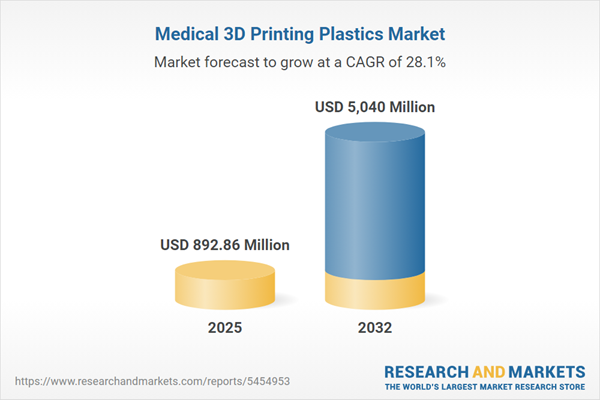Speak directly to the analyst to clarify any post sales queries you may have.
The medical 3D printing plastics market is evolving rapidly, empowering healthcare providers to achieve greater precision and customization. Advances in material science, regulatory developments, and collaborative ecosystems are transforming how medical devices and patient-specific solutions are delivered at scale.
Market Snapshot: Medical 3D Printing Plastics Market Trends and Growth
The medical 3D printing plastics market grew from USD 695.04 million in 2024 to USD 892.86 million in 2025 and is projected to reach USD 5.04 billion by 2032, reflecting a compound annual growth rate (CAGR) of 28.12%. This robust expansion is supported by widespread adoption of additive manufacturing in dental, orthopedic, prosthetic, and surgical applications. Driving forces include technological innovation, expansion of digital design platforms, and increased demand for patient-specific healthcare solutions among hospitals, device manufacturers, and research institutions.
Scope & Segmentation: Comprehensive Coverage of Material Types, Applications, and Regions
This report provides a detailed market analysis across multiple dimensions to offer strategic guidance for business leaders.
- Material Types: Photopolymer resin, including biocompatible, dental, high-temperature, and standard variants; powder types such as polyamide and polyether imide; thermoplastic filaments including acrylonitrile butadiene styrene, polyether ether ketone, polyethylene terephthalate glycol, and polylactic acid.
- Technology Platforms: Digital light processing, fused deposition modeling, material jetting, multi jet fusion, selective laser sintering, and stereolithography.
- Applications: Dental solutions (aligners, bridges, crowns, surgical guides), hearing aids, orthopedic solutions (implants, joint replacements, surgical planning models), prosthetics (cranial, limb), and surgical instruments.
- End Users: Dental laboratories, hospitals and clinics, medical device manufacturers, research institutions.
- Geographic Regions: Americas, including North and Latin America; Europe, Middle East & Africa; Asia-Pacific, covering over 30 key countries.
- Leading Companies: Strategic profiles include Stratasys Ltd., 3D Systems, Inc., Evonik Industries AG, BASF SE, Henkel AG & Co. KGaA, Arkema SA, Covestro AG, Koninklijke DSM N.V., Desktop Metal, Inc., and Solvay S.A.
Key Takeaways for Senior Decision-Makers
- Innovations in advanced photopolymer resins and thermoplastic filaments are enabling production of biocompatible, load-bearing, and sterilizable medical components for diverse clinical needs.
- Modern additive manufacturing technologies—such as digital light processing and selective laser sintering—are shortening prototyping cycles and strengthening regulatory submissions, streamlining product development pipelines.
- Integration of 3D printing plastics with digital software platforms enables customization, improved quality assurance, and regulatory compliance for patient-specific solutions.
- Healthcare providers and manufacturers are increasingly adopting additive workflows, transforming traditional supply chains and accelerating patient-centric innovation.
- Regional market dynamics differ; North America and Europe lead in adoption and infrastructure, while Asia-Pacific offers rapid expansion opportunities driven by manufacturing capabilities and healthcare investments.
- Collaborative partnerships among equipment makers, resin producers, healthcare facilities, and research institutions drive strategic differentiation and faster market access.
Tariff Impact: Navigating U.S. Tariffs and Global Supply Chain Shifts
The introduction of new U.S. tariffs in 2025 has led to elevated costs for essential feedstocks such as photopolymer precursors and specialized thermoplastics. Manufacturers are realigning supply chain strategies by sourcing alternative raw materials or establishing localized production. These tariff pressures have also influenced contract structures and prompted a shift toward vertically integrated business models to uphold both affordability and quality. The market’s resilience will increasingly depend on strategic supply chain adaptation and robust partnerships with domestic suppliers.
Research Methodology & Data Sources
This report utilizes a multi-stage research process involving structured interviews with industry experts, proprietary surveys among major stakeholders, and an exhaustive review of published literature and regulatory documents. Rigorous data triangulation ensures that quantitative and qualitative insights accurately reflect current market realities and future prospects.
Why This Report Matters for the Medical 3D Printing Plastics Market
- Identify growth opportunities and target investment areas with comprehensive segmentation by material, technology, application, and geography.
- Navigate evolving regulatory landscapes, tariffs, and supply chain shifts to maintain competitiveness and meet global compliance standards.
- Benchmark against leading companies and evaluate strategies for partnership, innovation, and operational integration to enhance value creation.
Conclusion
The medical 3D printing plastics market is poised for ongoing transformation. Leaders focused on research, partnerships, and agile supply chains will be best equipped to advance patient-centric healthcare and realize sustainable growth in this competitive segment.
Additional Product Information:
- Purchase of this report includes 1 year online access with quarterly updates.
- This report can be updated on request. Please contact our Customer Experience team using the Ask a Question widget on our website.
Table of Contents
3. Executive Summary
4. Market Overview
7. Cumulative Impact of Artificial Intelligence 2025
Companies Mentioned
The companies profiled in this Medical 3D Printing Plastics market report include:- Stratasys Ltd.
- 3D Systems, Inc.
- Evonik Industries AG
- BASF SE
- Henkel AG & Co. KGaA
- Arkema SA
- Covestro AG
- Koninklijke DSM N.V.
- Desktop Metal, Inc.
- Solvay S.A.
Table Information
| Report Attribute | Details |
|---|---|
| No. of Pages | 197 |
| Published | October 2025 |
| Forecast Period | 2025 - 2032 |
| Estimated Market Value ( USD | $ 892.86 Million |
| Forecasted Market Value ( USD | $ 5040 Million |
| Compound Annual Growth Rate | 28.1% |
| Regions Covered | Global |
| No. of Companies Mentioned | 11 |









